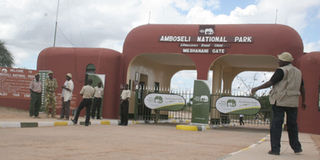August in Amboseli

Photo/FILE
One of the Amboseli National Park gates.
In the Maa language, the salty, dusty place we are currently in is called ‘empusal’, from which the name Amboseli derives.
As the day warms up, the hot air rises, pulling loose particles of dust skyward. These dust-devils spiral to the skies.
It’s the dry month but cool, with Kilimanjaro completely hidden from view even though we are in “Kilimanjaro’s Royal Court” as the Kenya Wildlife Service (KWS) brands its premier wildlife park.
The animals make for the swamps because there is no water outside. The elephants, wildebeest, zebra and giraffes face only one way – and that’s towards the water.
“In the evening they leave the park and return in the morning,” says Peter Kimani, the research assistant at Amboseli.
Gazetted in 1974, this 390-square-kilometres was declared a man and biosphere reserve in 1991 in recognition of its role in balancing human activities and the sustainable conservation of nature in the ecosystem.
The park provides critical natural resources to sustain community livelihoods which in turn ensure goodwill for the conservation of nature, reads a panel by the park’s airstrip.
Amboseli has stark landscapes. Dry, coarse grass gives way to complete dust bowls from where the plumes rise. Beautifully sculpted thorn-filled tortilis trees stand watch over it all.
The prehistoric Lake Amboseli attracts animals to it, yet it’s just a mirage where the sun’s rays strike its noxious soils that allow nothing to grow.
The only green is from the snows of Kilimanjaro, which melt and drain into Amboseli’s swamps. Driving out of the KWS guesthouse by Kimana Gate, we halt at the swamp, so lush and green.
It cuts across the bare dust bowl of Amboseli like a green belt with buffaloes and elephants almost submerged in it.
All the zebra, wildebeest and tommies have their necks craned and looking in the same direction.
“It looks like there must be lions,” says Kimani, who has been studying lions in Amboseli for a year.
True enough, as we follow the gaze of the herbivores we spot the three felines with their cubs moving about in the swamp.
They’re not on the hunt but the herbivores still keep alert. Kimani says there are 100 lions in the Amboseli ecosystem.
The swamps are full, with the elephants enjoying a bath in the Enkongo Narok swamp as pure, white, cattle egrets walk on their massive frames looking for insects to forage on.
At this point there are almost 1 500 elephants in the Amboseli ecosystem. Herds of wildebeest mingle with the zebra and everything seems calm.
A few metres away we climb Noomotio Hill from the Pleistocene era (which stretched from 2.5 million to 11 700 years ago and marked the end of the glacial period).
Noomotio, meaning “a hollow where water collects” in the Maa lingo, is a result of Kilimanjaro’s volcanic moods.
Kilimanjaro remains hidden in the clouds. An islet on the edge of the lake is the resting site for a flock of pelicans.
Driving further on, a herd of elephants browse on the tall glades of golden grass, which give way to a desert of stones that look very similar to Korr desert in Kaisut in northern Kenya.
“Amboseli is the dry season refuge,” comments Soila Sayialel from the Amboseli Elephant Research Project (AERP).
“Probably the first Maasai woman to work in research from the area, she jokes that she’s like the elephants of Amboseli who have stayed around all their lives.
The AERP, started by Dr Cynthia Moss in 1972, today boasts of the longest studied pachyderms in the wild. There are 1 250 elephants in Amboseli, each with a file.
However, Amboseli National Park is dependent on the greater Amboseli-Tsavo ecosystem where community group ranches such as Imbirikani and Kuku offer safe passage to the wildlife between Amboseli, the Chyulus and Tsavo.
These conservancies harbour their own lodges where local communities are the shareholders.
“They are important elephant migratory and disperal areas,” states the senior warden of Amboseli, Richard Chepkwony.
The elephant’s life is one long meal and must migrate in search of fresh pasture which allows time for the land to regenerate otherwise it would turn into a desert.
“That’s why Amboseli National Park is not fenced,” says Chepkwony.
Email: [email protected] Blog: rajuafrica.blogspot.com




